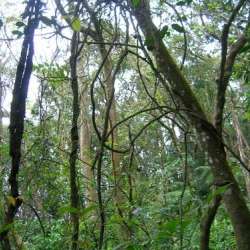In the forest can be found indigenous shrubs, which include; Rose myrtyle, Blood red melastoma, Common melastoma, a wide variety of hollies, Gordinias, Thick-leafed sweet leaf, Cow’s ear, Hong Kong hawthorn, Gleditsia australis, Indian gooseberry, etc.The makeup of the flora of the forest includes the vines, lianas and creepers, some indigenous others exotic and include invasive noxious species, such as the Triffid weed, Bitter vine or Mile a minute vine, Chinese knotweed, balloon vine, dog strangler vine, Lantana, Dodder, Morning glory to the poisonous Goat horns creeper and Crab’s eye or Rosary pea. Colourful vines include; Golden shower, honeysuckle, bougainvillea and Wisteria. Growing up tree trunks one can see the African evergreen vine or Arrow leaf vine, this plant changes its leaf shape – on the ground it is an arrow head shape, but as it climbs, it becomes larger and the shape changes dramatically, also look out for the Money vine, a very common plant found in many offices and homes.
Grasses and ferns abound and include; Buffalo grass, Natal grass, finger grass, Plume grass and of course the bamboo species, Wood fern, Semi-pinate fern, Maidenhair ferns, Forked fern, etc.
Indigenous trees not yet mentioned include the Machilus species, Chinese mahogany, Wampi, Chinese hackberry, China berry, Pond spice, Ivy tree, Dragon trees, microcos paniculata, Pop-gun tree, etc.
Common wayside herbs include Creeping wood sorrel also known as Sleeping beauty, Large flowered pink sorrel, Purple jasmine or 4 o’clock flower, Madagascar periwinkle, Wedelia, Fleabane, Steetz, etc
Many of the island industries have all but vanished over the years, such as the Tannery, which was situated by Tannery beach, various piggeries like the ruin by the lone palm, fruit orchards – some still remain by Pak Kok village, especially Litchi orchards. Market gardens and rice paddies were located in the valleys. Being an island, fishing and drying of fish is still carried on in some parts. After a visit to the Forest why not visit one of the many seafood restaurants located in Yung Shue Wan, before returning to HK.
With a frost free and subtropical climate, the island is an ideal location to find fruit trees such as; Litchi, Longan or Dragon’s eye, Mango, Custard apple or Sugar apple, Peach, Mandarin, Orange, lemon, Pomelo, Sapodilla, Pawpaw, mulberry, Guava, Loquat, Star fruit, Java apple, Rose apple, pomegranate, Jack fruit, Tropical almond, Coconut and Banana which is not really a fruit but a berry, etc.
Giant upright elephant ear plants can be found in the shade below the forest canopy, along with species of Lilies, Hibiscus, Rhododendrons, Chloredendrons, Chinese privet, etc.
The flora of the forest is complemented by the fauna of the island, which includes a large variety of insects – butterflies, moths, Beatles including the noise cicadas, ants (look out for the weaver ants nests in the tree foliage), spiders, mosquito’s, etc. As the forest has regenerated, many bird species have returned including, the Black drongo (a summer visitor), Thick billed crow, Coucal, Koel, Oriental magpie robin, Indian cuckoo (summer visitor), Barn swallow and swift (summer visitors), Black kite, Magpie, Tree sparrow, Taylor bird, Hwamei, Japanese white eye, Red whiskered bulbul, Chinese bulbul, Sooty-headed bulbul, White fronted water hen, Large egret, cattle egret, Chinese pond heron, Chinese reef heron, Pied and Grey wagtails, Common and White-throated kingfishers, Scaly-breasted and White-rumped munias, etc.
As the Japanese kept a large variety of snakes for experimental purposes on the island during WW2, on leaving they released these into the wild. Most snakes will avoid human contact and retire when they hear one approach. But just be aware when hiking the forest.
This is by no means a definitive dissertation, but merely to highlight the extreme diversity of flora and fauna which can be found in and around Lamma Forest, and hope this has stimulated your interest, to explore further the natural environment found on this unique island only 25 minutes by ferry from HK.
All flora has been categorised into plant families and then further identified as the species in question, Latin has been used as the universal medium of identification. We have given mostly the English common names used in Hong Kong, however, some trees and herbs, have numerous names depending on which part of the world one lives in and in numerous different languages, suffice to say, the common names can be ambiguous, therefore for exact identification the scientific species name should be referred to, where these occur we have used italics.



